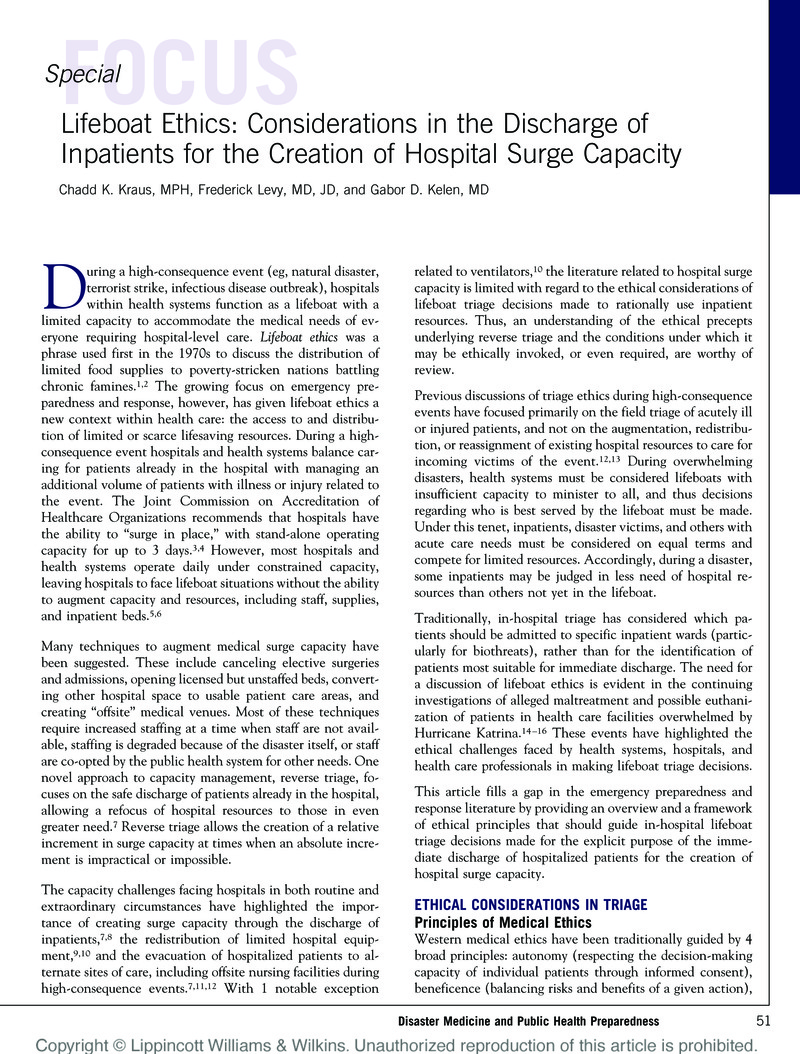Crossref Citations
This article has been cited by the following publications. This list is generated based on data provided by Crossref.
Kelen, Gabor D.
McCarthy, Melissa L.
Kraus, Chadd K.
Ding, Ru
Hsu, Edbert B.
Li, Guohua
Shahan, Judy B.
Scheulen, James J.
and
Green, Gary B.
2009.
Creation of Surge Capacity by Early Discharge of Hospitalized Patients at Low Risk for Untoward Events.
Disaster Medicine and Public Health Preparedness,
Vol. 3,
Issue. S1,
p.
S10.
Childers, Ashley Kay
Visagamurthy, Gurucharann
and
Taaffe, Kevin
2009.
Prioritizing Patients for Evacuation from a Health-Care Facility.
Transportation Research Record: Journal of the Transportation Research Board,
Vol. 2137,
Issue. 1,
p.
38.
Childers, Ashley
and
Taaffe, Kevin
2010.
Healthcare Facility Evacuations: Lessons Learned, Research Activity, and the Need for Engineering Contributions.
Journal of Healthcare Engineering,
Vol. 1,
Issue. 1,
p.
125.
Palmer, Susan K.
2010.
Clinical Ethics in Anesthesiology.
p.
270.
Jose, Mini M.
2010.
Cultural, Ethical, and Spiritual Competencies of Health Care Providers Responding to a Catastrophic Event.
Critical Care Nursing Clinics of North America,
Vol. 22,
Issue. 4,
p.
455.
Farrar, Jocelyn A.
2010.
Pandemic Influenza.
JONA: The Journal of Nursing Administration,
Vol. 40,
Issue. 1,
p.
1.
Caro, J. Jaime
DeRenzo, Evan G.
Coleman, C. Norman
Weinstock, David M.
and
Knebel, Ann R.
2011.
Resource Allocation After a Nuclear Detonation Incident: Unaltered Standards of Ethical Decision Making.
Disaster Medicine and Public Health Preparedness,
Vol. 5,
Issue. S1,
p.
S46.
Van Cleve, William C.
Hagan, Pat
Lozano, Paula
and
Mangione-Smith, Rita
2011.
Investigating a Pediatric Hospital’s Response to an Inpatient Census Surge During the 2009 H1N1 Influenza Pandemic.
The Joint Commission Journal on Quality and Patient Safety,
Vol. 37,
Issue. 8,
p.
376.
Emmerich, Nathan
2011.
Anti-theory in action? Planning for pandemics, triage and ICU or: how not to bite a bullet.
Medicine, Health Care and Philosophy,
Vol. 14,
Issue. 1,
p.
91.
WATSON, SAMANTHA K.
RUDGE, JAMES W.
and
COKER, RICHARD
2013.
Health Systems’ “Surge Capacity”: State of the Art and Priorities for Future Research.
The Milbank Quarterly,
Vol. 91,
Issue. 1,
p.
78.
Childers, Ashley Kay
Mayorga, Maria E.
and
Taaffe, Kevin M.
2014.
Prioritization strategies for patient evacuations.
Health Care Management Science,
Vol. 17,
Issue. 1,
p.
77.
Khademi, Amin
Saure, Denis R.
Schaefer, Andrew J.
Braithwaite, Ronald S.
and
Roberts, Mark S.
2015.
The Price of Nonabandonment: HIV in Resource-Limited Settings.
Manufacturing & Service Operations Management,
Vol. 17,
Issue. 4,
p.
554.
Kelen, Gabor D.
Sauer, Lauren
Clattenburg, Eben
Lewis-Newby, Mithya
and
Fackler, James
2015.
Pediatric Disposition Classification (Reverse Triage) System to Create Surge Capacity.
Disaster Medicine and Public Health Preparedness,
Vol. 9,
Issue. 3,
p.
283.
Therrien, Marie-Christine
Normandin, Julie-Maude
and
Denis, Jean-Louis
2017.
Bridging complexity theory and resilience to develop surge capacity in health systems.
Journal of Health Organization and Management,
Vol. 31,
Issue. 1,
p.
96.
Pollaris, Gwen
De Bondt, Frieda
and
Sabbe, Marc
2023.
Reverse triage: a systematic review of the literature.
Frontiers in Disaster and Emergency Medicine,
Vol. 1,
Issue. ,
Sellers, David
Hughes, Lynda
Crilly, Julia
and
Ranse, Jamie
2024.
Practical considerations of implementing disaster crisis standards of care in the intensive care unit: A scoping review.
International Journal of Disaster Risk Reduction,
Vol. 105,
Issue. ,
p.
104412.





